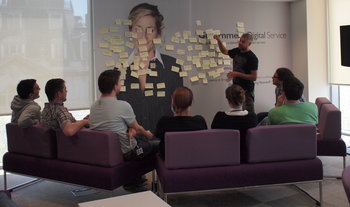|
| |
Agile is a project methodology that began as a short statement of 12 software development principles entitled Manifesto for Agile Software Development published by a group of 17 prominent software developers in 2001.The principles had a profound effect on software development as a dozen or more agile methodologies sprang from them. With time, several other widely accepted principles have arguably evolved. The following principles are commonly associated with agile methodologies.
Continuous Delivery Agile frequently delivers. Welcoming Change Change is accepted at any time.Working Software Delivery is measured in working software.Short Timescales Delivery cycles can be counted in weeks not months.Integrated Teams Teams include business and technical members. Everyone you need to deliver is on the team. TrustTeams are trusted.High Performance Agile only works with motivated, high performance teams.
Face To Face A team sits close together and face-to-face communication is preferred.Sustainable Pace Work is at a sustainable pace that can be continued indefinitely.Good Design Teams prioritize good design.SimplicityDefined in the original manifesto as the "art of maximizing the amount of work not done."Self Organizing Teams Teams are allowed to self-organize without management interference.Generalist Roles Teams may have different roles but these are kept as general as possible. RetrospectiveTeams take time to reflect on recent performance to identify improvements.TimeboxingAgile teams have a tendency to timebox meetings and delivery cycles.Continuous Integration Work is continuously integrated into a single releasable product.Small Teams Agile teams tend to be small and this is often considered of importance.Last Responsible Moment No big upfront plan, architecture or design.Method Tailoring Agile encourages teams to customize methodologies and develop a strong team culture.|
Area | | Definition | An evolving set of principles for delivering projects. | Origins | Manifesto for Agile Software Development, 2001 | Related Concepts | |
Agile
This is the complete list of articles we have written about agile.
If you enjoyed this page, please consider bookmarking Simplicable.
A complete guide to continuous delivery including a process overview and comparisons.
A list of basic scrum techniques and conventions.
A list of common project risks.
A list of basic project management techniques.
A definition of workaround with examples.
A list of project branding techniques.
An overview of project stakeholder management with examples.
A definition of action plan with examples.
The primary types of cost overrun.
The definition of document control with examples.
A guide to project oversight.
A definition of design driven development with examples.
A list of common project risks.
A list of common project stakeholders.
A list of common business risks.
The difference between a risk and an issue.
The five things that can be done about risk.
The definition of secondary risk with examples.
A guide to creating a risk register with an example.
A definition of risk perception with examples.
The common types of implementation.
A reasonably complete guide to project risk management.
TrendingThe most popular articles on Simplicable in the past day.
Recent posts or updates on Simplicable.
Site Map
© 2010-2023 Simplicable. All Rights Reserved. Reproduction of materials found on this site, in any form, without explicit permission is prohibited.
View credits & copyrights or citation information for this page.
|

































